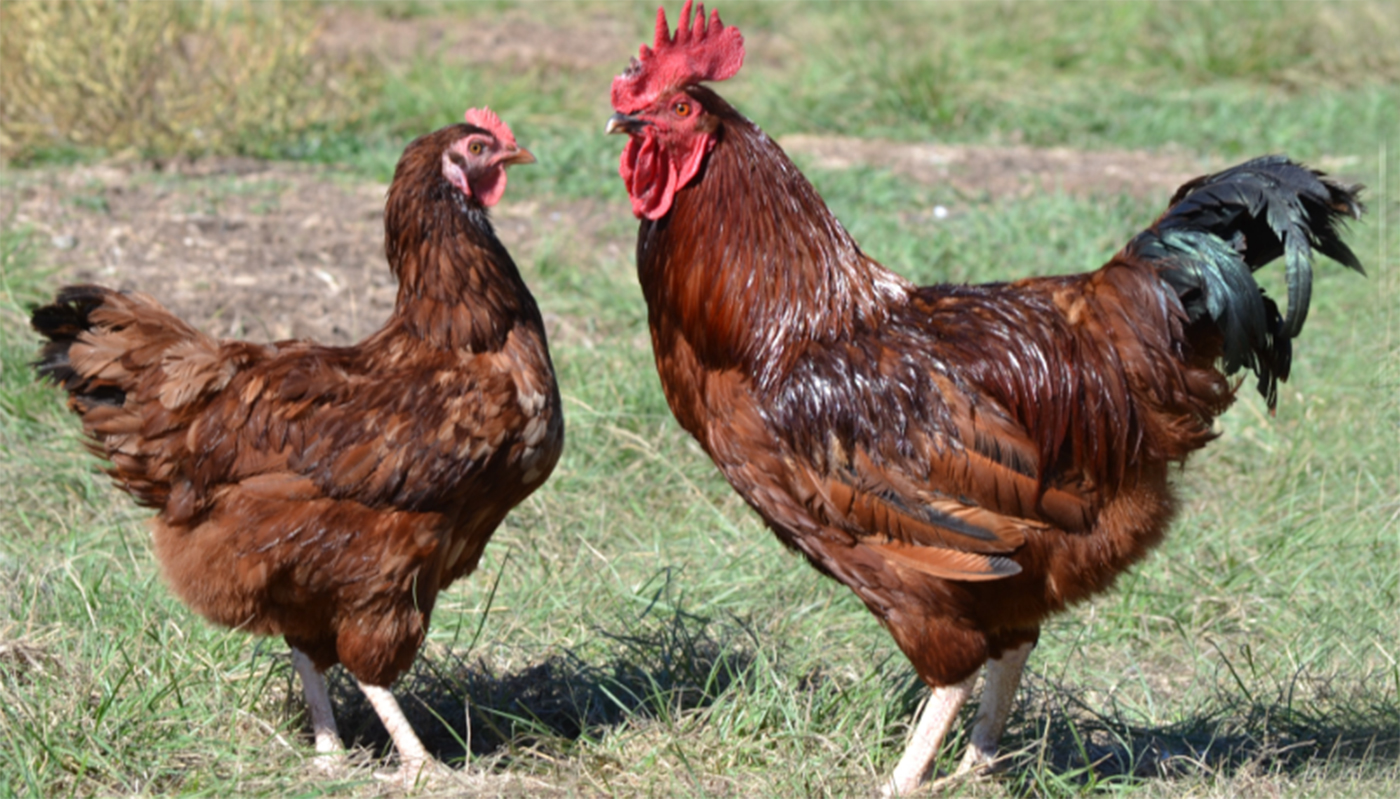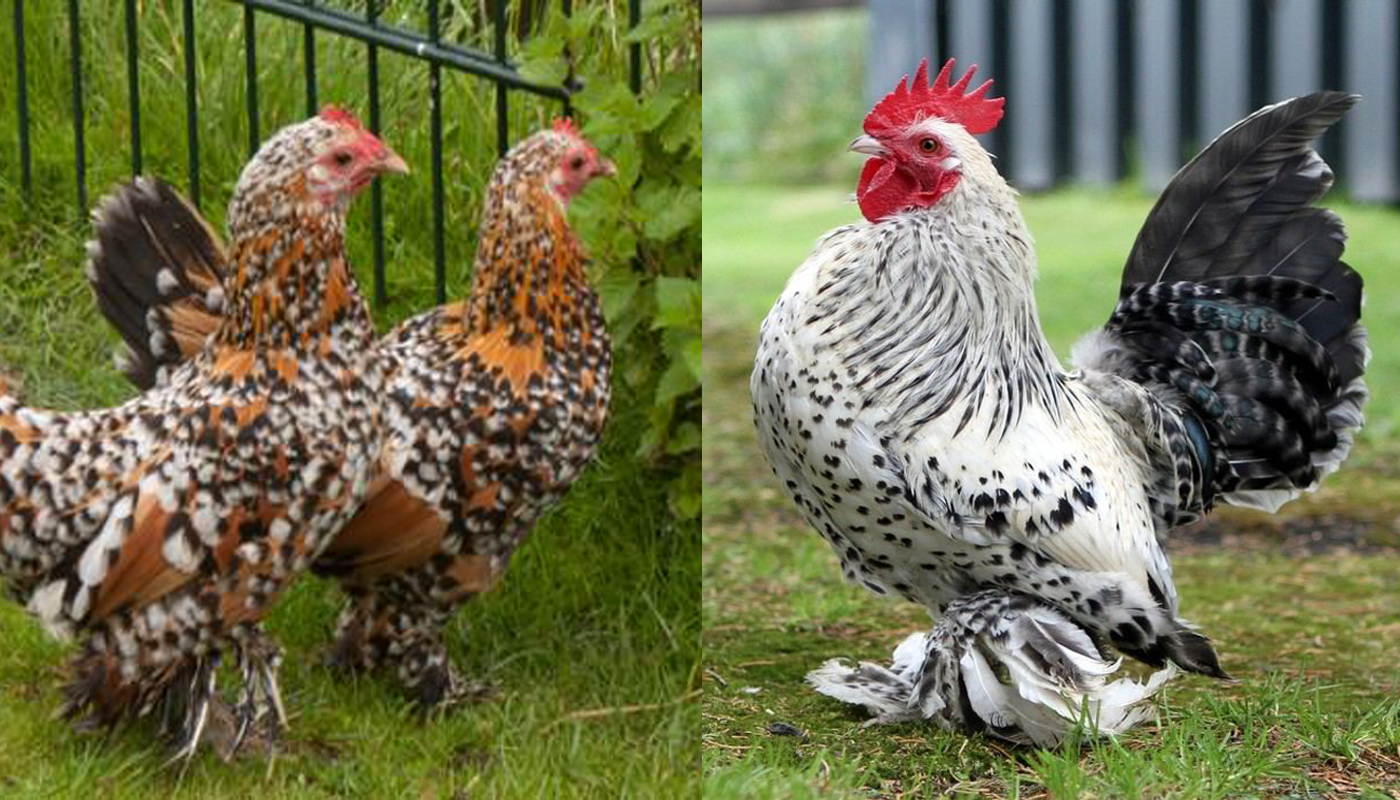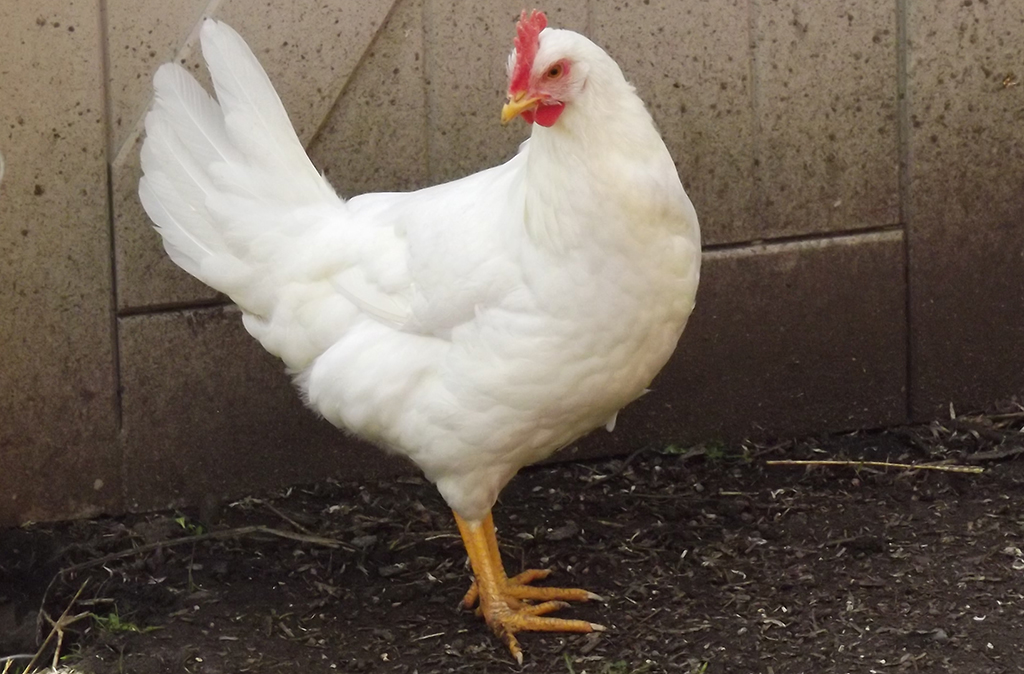
Rose comb Bantams are true Bantams as they do not have a large chicken counterpart. Although they are not a very easy breed to keep, breed or maintain they are excellent show birds for the Poultry Exhibitor enthusiast.
For the poultry keeper who does not mind the extra bit of work, these feisty little chickens can be a true delight to own.
They stand tall and proudly erect in true Bantam style like little soldiers standing to attention. Not only are they great for the poultry showroom floor but they make an exquisite ornamental chicken for your backyard.
They come in a variety of glossy colors that blend in with their bright red combs, wattles and white earlobes.
They are also one of the oldest Bantam breeds around and the foundation for many of the other Bantam breeds we know of today.
| Country of Origin: | United Kingdom |
| American Poultry Association: | Yes – They are recognized as a breed of chicken in the United States. The Rosecomb was accepted to the Standard of Perfection by the American Poultry Association in 1874 |
| Chicken Category: | Bantam Breed |
| You may Also Like: | TOP 10 BANTAM CHICKEN BREEDS FOR BEGINNERS |
| Chicken Class: | Rose Comb Clean Legged |
| Bantam Variety Available? | There is only a Bantam Breed it is a True Bantam |
| Good Starter Chicken? | No, it is for the more experienced poultry keeper due to their temperamental flight natures |
IDENTIFICATION⇒ |
Appearance/Body: Rosecomb Bantams have a strong posture with puffed out chests. Their large tails are held upright to create a deep U-Bend from its back to its long neck which is held high. Their wings are held tightly to their sides and point downwards almost touching the ground. They have a large bright red rose comb and smaller bright red wattles. Their earlobes are white and lend a startling contrast to their dark feathers and red faces.
The males have long black flowing sickles feathers and hocks. Their legs are long, slender and are a clean slate blue with four toes.
Color(s) Black, White and Blue are recognized by the APA
Barred, Ginger Red, Birchen, Golden Duckwing, Lemon Blue, Black, Black-Breasted Red, Mille Fleur, Black Tailed Red, Mottled, Blue, Porcelain, Blue Red, Quail, Brown Red, Buff, Red Pyle, Buff Columbian, Siver Duckwing, Columbian, Splash, Wheaten, Crele, White and Exchequer are recognized by the American Bantam Association.
Comb: They have a rose comb
Ave. Weight: Pullet: 20 oz
Hens: 22 oz Cockerel: 22 oz Rooster: 26 oz |
PURPOSE⇒ |
Eggs: They are very poor egg layers.
They lay very small cream/tinted eggs They lay about 50 eggs per year They will lay throughout the year They start to lay eggs from around 24 weeks old.
Meat: They have white skin
They are not meat birds
Breeding: Due to a genetic trait the Rosecomb roosters may have low fertility. They can be bred but breeding Rosecomb chickens are not for the novice.
The hens do not get broody They do not make good brood hens They will not sit on their eggs They will raise their chicks and make very good mothers. They also make very good foster mothers to other chickens/breeds chicks
Show Bird: The Rosecomb Bantam was bred to be a show bird
Pets: If they are raised correctly from hatchlings they can make good little pets
Other: These beautiful Bantams will liven up any coop but do require quite a lot of word to raise. They have to have quite a bit of special attention to ensure they are not bullied if in a mixed flock. Even though the roosters tend to be friendly they can get really aggressive. They will cause trouble with bigger birds.
|
CHARACTERISTICS |
|
|---|---|
| Life Expectancy: | The average lifespan is 8 years |
| Health: | The adults are quite a hardy breed but are not too good in extremely cold weather and their combs are prone to frostbite. |
| You may Also Like: | HOW TO TELL IS A CHICKEN IS SICK |
| Temperament: | They are a little on the shy side, extremely active but can be friendly and easy to handle if raised correctly from a hatchling. |
| Flyers? | They are excellent flyers and really love to fly |
| Noisy Birds? | They are very noisy for such little birds |
| Interaction with other chickens: | They do not mind mingling with their own size but due to their flighty cheeky natures may get bullied by bigger birds in a mixed flock. |
| Good with kids? | Due to their shy flighty natures, they are not the best chickens to have around children |
| Socialize Behavior? | They tend to shy away from other domestic animals. |
| You may Also Like: | HOW TO SOCIALIZING YOUR NEW CHICKENS |
| Known predators: | Always keep an eye on domestic pets such as dogs and cats. If hawks and or foxes are in your area it is always best to take precautions. Check with local animal shelters, zoos, vets, animal control and or pet stores about common predators in your area. |
| Conservation Status: | These birds conservation status is recorded as “at risk” |
IDEAL ENVIRONMENT |
|
|---|---|
| Garden Size: | These little chickens do not take up much room and are best suited to the smaller to medium sized gardens. |
| Ideal Climate: | They prefer moderate climates that are not too hot or too cold. They will need lots of shady spots in the heat and warm cozy places in the extreme cold. |
| Ideal Coop: | The rule of thumb for any coop is 50 cm x 50 cm per hen/rooster in the coop. Ensure there is a good space for the nesting boxes and nightly roosting rails at least 1.5 inches wide. Good ventilation for air but not too drafty especially in winter. It is always a good idea to raise the coop off the ground to give the birds a dry place to roost and lay especially in wet weather. For Bantam breeds, it is best to have the coop in a protected shed or barn. |
| Ideal Coop Run: | Very flighty little chickens so for their own safety and to keep your Rosecomb Bantams at home it is best to completely cover the coop run. Special precautions are especially necessary for the White variety as they are more susceptible to night predators that then darker colors. |
| Ideal Flock Size: | These sociable chatty chickens like to have more than one friend in their flock. |
| Special Instructions: | They need to be raised correctly in order to tame them otherwise they can be quite wild and disruptive. |
| Accessories: | The following accessories are ideal for your coop: Nesting boxes Straw for the boxes and roosting area Roosting rails Perches Water troughs/bowls Food bowls/feeders Heating lamp(s) Animal carrier for transport purposes |
| You may Also Like: | 45 FREE DIY CHICKEN COOP PLANS, TUTORIALS AND DESIGNS |
WHERE TO BUY THEM |
|
|---|---|
| Live Poultry Outlets: | There are a few live poultry outlets that stock these Bantams. |
| Internet Poultry Websites: | There are a few Poultry Farmers that sell online. |
| Organizations: | The American Bantam Association, American Poultry Association and the American Livestock Conservancy will have extra information on the Rosecomb breed and may be able to help with reputable poultry sellers. |
| Breeders Clubs: | The Rosecomb Bantam Federation is a website well worth checking out especially for breeders and show bird standards. Feather Site is another very informative website with a list of breeders and clubs. |
| Other: | The organizations and or breeders listed above may also have a host of valuable information about your chickens. They will also be able to provide you with any special instructions, problems, etc. about your chickens. |
HISTORY
The Rosecomb is one of the oldest true Bantam breeds around. In England, there are records of the breed dating back to the 14th century.
King Richard III was one of the persons responsible for the rise in popularity of the breed when he took an interest in them and started to breed them.
Their popularity continued amongst poultry breeders and they were shown in poultry shows all around the globe well into the 19th century.
These little birds are still a popular Bantam breed today and a lot of the newer Bantam breeds have been bred from their lineage.
Rosecombs are kept solely for competition breed or ornamental purposes these days.
Although this breed is generally a very active and hardy little breed due to a genetic trait that rose comb chickens have males may have low fertility. The hens rarely if ever go broody and their chicks of this breed have a very high mortality rate.
Although they are mostly friendly to humans the roosters are rather aggressive to other roosters/breeds.
NOTES / SPECIAL INSTRUCTIONS
As they are registered as “at risk” conservation status they may need an extra license to own or keep in your garden. For advice on what the bird’s conservation status and orders are please check with your local conservation department.
For breeders, it is imperative that you always check your bird’s bloodlines and ensure you are buying your birds from a reputed breeder/farm. In order to sell birds of such stature, they have to be recorded and documented, always check with local animal breeding organizations for these records.
These legitimate documents are also required should you wish to show your bird(s) in various poultry shows/competition showings.
For information and advice on adopting rescued animals, you can visit or contact your local animal welfare center.
Video
USEFUL LINKS
- Caring for your Chicken
- Feeding
- Health
- Socializing your Chicken
- Breeding Chicken
- Raising Chickens A-Z
- Hatching Eggs
- What is Molting
- Animal Shelter (ASPCA)
- American Veterinary Medical Association
- American Poultry Association
- American Animal Welfare Society
- American Animal Control
- American Animal Husbandry Society
References
- https://en.wikipedia.org
- https://livestockconservancy.org
- https://www.roysfarm.com
- https://www.mypetchicken.com
- https://www.backyardchickens.com
- https://www.feathersite.com/
 Rhode Island Red Chicken Breed – Everything You Need to Know
Rhode Island Red Chicken Breed – Everything You Need to Know EXTERNAL PARASITES ON A CHICKEN
EXTERNAL PARASITES ON A CHICKEN Belgian Bearded D’Uccle Chicken Breed – Everything You Need to Know
Belgian Bearded D’Uccle Chicken Breed – Everything You Need to Know 10 Chicken Breeds for the Colder Climates
10 Chicken Breeds for the Colder Climates Catalana Chicken Breed – Everything You Need to Know
Catalana Chicken Breed – Everything You Need to Know Booted Bantam Chicken Breed – Everything You Need to Know
Booted Bantam Chicken Breed – Everything You Need to Know Top 10 Bantam Chicken Breeds for Beginners
Top 10 Bantam Chicken Breeds for Beginners CONDITIONS THAT AFFECT THE EYES OF A CHICKEN
CONDITIONS THAT AFFECT THE EYES OF A CHICKEN Legbar Chicken Breed – Everything You Need to Know
Legbar Chicken Breed – Everything You Need to Know Chicken Vaccinations and why they are Important to a Flock
Chicken Vaccinations and why they are Important to a Flock The Top Chicken Breeds for Egg Laying
The Top Chicken Breeds for Egg Laying Top Chicken Breeds for Free Ranging
Top Chicken Breeds for Free Ranging